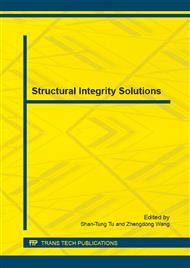p.89
p.96
p.104
p.114
p.121
p.127
p.133
p.139
p.145
Fatigue Behavior of K447A Superalloy under Low Cycle Fatigue and Creep-Fatigue Interaction Conditions
Abstract:
Strain-controlled low cycle fatigue (LCF) and creep-fatigue interaction (CFI) tests of K447A are conducted at 760oC in order to investigate the effects of different dwell times and strain ratios on the fatigue behavior and life. For the cases of stain ratio Rε=-1 with balanced hold time, the tensile and compressive mean stresses will generate. For the case of stain ratio Rε=-1 with compressive holding 60s, the tensile mean stress will produce. For the case of stain ratio Rε=-1 with tensile holding 60s, the compressive mean stress will produce. For the cases of stain ratio Rε=0.1 and Rε=-1with no hold time, the tensile mean stress will produce. The cyclic damage accumulation (CDA) method and modified CDA method were employed to predict the fatigue life for K447A, respectively. The fatigue life predicted by CDA method is within the scatter band of 18.2X. The fatigue life predicted by the modified CDA method agrees very well with the experimental life and the predicted life is well within the scatter band of 3.1X, which means that the modified CDA method is able to consider the influences of dwell time and strain ratio on the fatigue life of K447A.
Info:
Periodical:
Pages:
121-126
Citation:
Online since:
April 2015
Authors:
Price:
Сopyright:
© 2015 Trans Tech Publications Ltd. All Rights Reserved
Share:
Citation:


